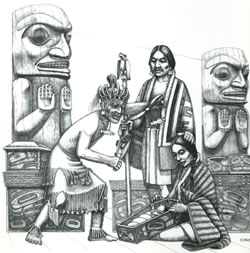The Prince and the Salmon People
Illustrated by Duane Pasco
Study Guide for The Prince and the Salmon People
 Excerpt from the book:
Excerpt from the book:
Niawas-ye shook his rattle, blessing the child. This boy is special. He enters our world just as the first spring salmon comes to
us. He will bring a great gift to our people; he will remind us how important it is to respect and honor the salmon.
Later, the shaman placed a necklace with a salmon charm around the baby’s neck.
When the prince grew older he wore his necklace every year during the season of the First Salmon, and the runs were plentiful.
He and his companion, a slave boy whom the chief appointed to stay with him, watched the men fishing and longed to join them.
Years went by and life in the village became busier. Some rituals were performed less often or not at all. Gradually, the prince
forgot to wear his necklace, until one day he couldn’t even remember where he had put it. That year, he and his companion were
finally old enough to catch spring salmon with the men, but almost no fish swam by the village.
 Background
Background
Different versions of the Salmon People legend have been told for centuries by many tribes of the Northwest Coast Indians.
Though the tellings may differ in detail from tribe to tribe and era to era, all versions express the Indian belief that animals
have spirits like people, and can move freely between the animal and human worlds, choosing to feed humans when we
approach them with proper respect and ceremony. This story is based on anthropologist Franz Boaz's accounts of traditional
Tsimshian legends and interviews with contemporary Tsimshian elders and craftsmen.
About the Tsimshian
In their traditional way of life, the Tsimshian (Tsim-shan or TSIM-shee-an) fished and hunted in groups of families related through
the women. They lived in large cedar-plank houses in northwest British Columbia along the Skeen and Nass Rivers and later, in
the southeastern Alaska community of Metlakatla. They are known for their graceful canoes and objects made out of wood such
as totem poles, masks, and carved wooden boxes.
Resources for Teachers and Students
I Am Salmon: An Exploration of Salmon and Self is a program of One Reel
that helps young people learn about salmon, watersheds, and themselves. Please contact them directly for a copy of their
Teacher's Packet (Creel & Tackle Box) on I Am Salmon: An Exploration of Salmon and Self, an Educator's Collection
of resources and Activities for the Interdisciplinary Study and Appreciation of Watersheds and People of the North Pacific Rim.
One Reel, First Fish: Wild Salmon Project. 1999.
Resources for Teachers
Kudatan Kahidi: The Salmon Box
Salmonpeople by Peter Donaldson, an educator, performance artist, and storyteller
|


 Excerpt from the book:
Excerpt from the book: